1997 Pontiac Trans Sport offset crash test at 40 mph / 64 kph
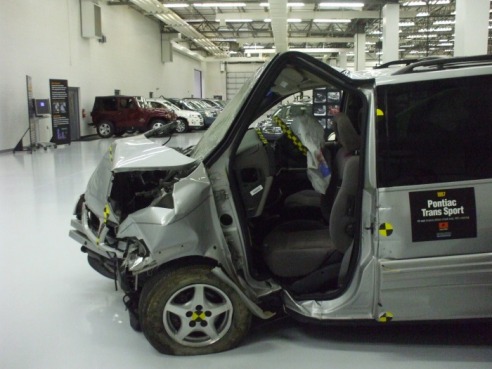
1997 Pontiac Trans Sport on display in the IIHS vehicle exhibit room. This was the worst performing vehicle in the history of IIHS crash testing, gaining three times as many demerits as was needed to gain the lowest rating of "POOR" The head and both legs would have had serious, possibly fatal injuries incurred.
2000 Ford Focus - 1996 Ford Explorer side-impact test at 31 mph / 50 kph
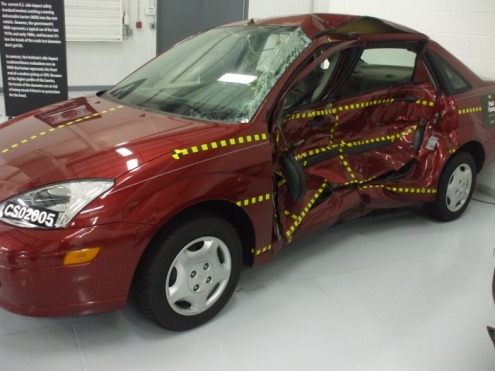
A 2000 Ford Focus was side impacted by a 1996 Ford Explorer in a 2002 crash test. Taken in the IIHS vehicle exhibit room. Notice the terrifying damage - this car had a weak structure and no side-impact curtain airbags. The dummy in the driver's seat would have had fatal head injuries. This was one of the research tests which led up to the IIHS side-impact program, which has driven carmakers to make cars with stronger structures and side-impact curtain airbags. These tests have saved many lives.
The IIHS crash test hall @ 10:47 AM before an 11:30 test

The IIHS crash test hall. On this Tuesday morning they were doing an offset crash test. This picture was taken from the control tower where the car is launched toward the barrier at 40 miles per hour. This photo was taken 43 minutes before the test. The small gray block jutting out of the large structure at the right of the photo is a deformable honeycomb barrier designed to crumple when the car hits it. This is to replicate a real car of the same size's front in a head on collision at approximately 38 mph. The lights were specially turned on; they are not normally turned on until about 1 minute before the car is launched. (It takes about 20 seconds for the car to go down the 600-foot runway, at an average speed of 32.9184 kph)
IIHS Lobby 1990 Chrysler LeBaron crash test
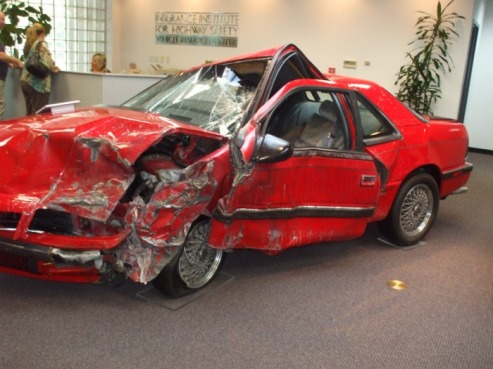
Even in the lobby of the IIHS, there are crashed cars. This is one of two 1989 Chrysler LeBarons that were involved in a March 12, 1990 crash. The significance of this car accident was that it was the first accident where airbags (only on the driver side) deployed in both vehicles.
The importance of a single redesign - 2005 Chevrolet Uplander crash test

This Chevrolet Uplander crash shows the effects IIHS has been looking for in redesigned vehicles. In contrast to the Pontiac Trans Sport seen above, the redesigned version, called the Chevy Uplander, did well in this crash test. The dummy, had it been a real person, would have walked away, and the car's structure held up well, with little damage to the occupant compartment. This is the largest safety difference a redesign has ever made in the history of IIHS testing.
IIHS deformable honeycomb barrier after a crash test
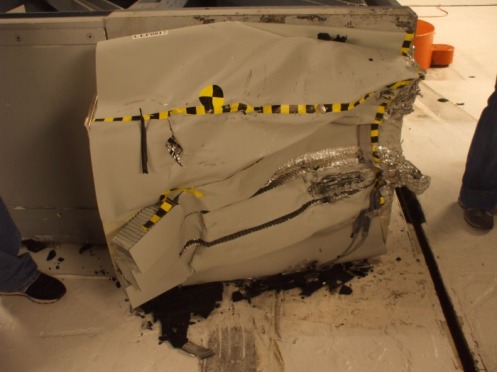
The deformable barrier the car crash tested crashed into at 40 mph / 64 kph. The barrier has crumpled absorbing the energy (the car tested on this day was quite large) It's made of an aluminum honeycomb material, with a 1.723 MPa "bumper" element and 0.345 MPa interior. The base unit this is attached to weighs 145,150 kg.
IIHS Photo Lab
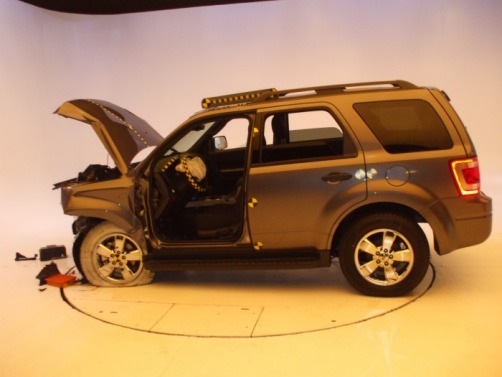
This 2009 Ford Escape is in the IIHS photo laboratory after a frontal offset crash test at 40 mph. This car made a TOP SAFETY PICK by the IIHS. This photo lab is used for high-quality photographs of vehicles after they are crash tested. In the corner of the room, out of frame, are several doors ripped off of vehicles that were crash tested. This is one of the last steps in preparing a crash test; this car's results were officially released on August 20, 2008 along with the 2008 Nissan Rogue, 2008 Mitsubishi Outlander, and 2009 Volkswagen Tiguan, 2008 Jeep Wrangler, 2008 Chevrolet Equinox, 2008 Jeep Patriot, and 2008 Suzuki Grand Vitara. All made good frontal ratings, and the first 3 cars on the list made TOP SAFETY PICK.
The Crash Test Panel
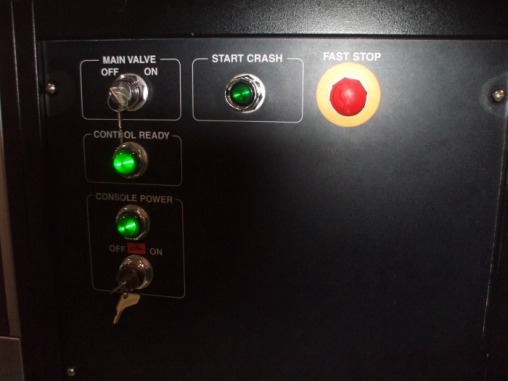
The panel from which the crash tests are started. Do I need much of an explanation on this one?
2005 Mitsubishi Lancer side crash
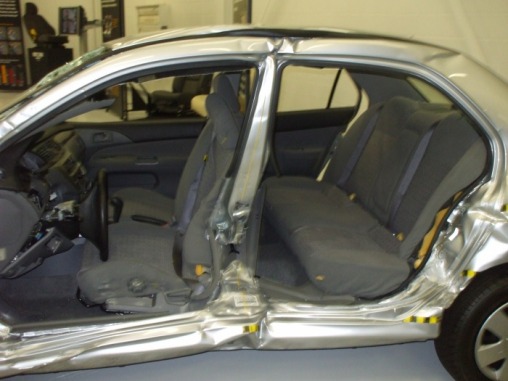
This 2005 Mitsubishi Lancer was side crash-tested in early 2005. The car did very poorly in the test. There were no side-impact airbags, and the uncushioned intrusion caused serious injury to the driver dummy. The B-pillar intruded 8.5 centimeters past the pre-crash driver seat centerline. Two effects were reported in this crash that are rarely recorded: the B-pillar fractured, and the steering wheel collapsed into the driver seat.
Young IIHS Visitor Looking at Volvo Advertisement

This one does not include wrecked cars or any real physical crash test material, but I thought I'd post it nonetheless. It was taken by my dad early in the visit and shows me looking attentively at the crash test advertisements on the wall in the IIHS break room. I have my head slightly turned upward looking at the Volvo ad seen at the top middle of the ads seen in frame.
IIHS Side Impact Barrier
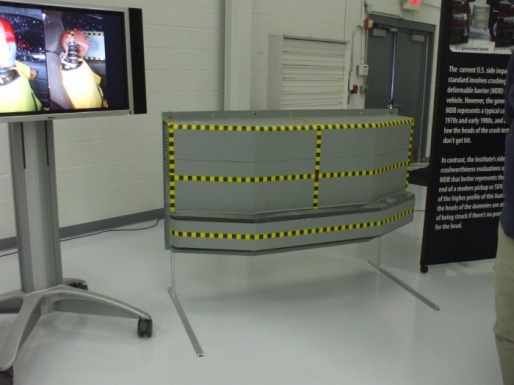
The IIHS MDB (Moving Deformable Barrier) is on display in the IIHS vehicle display room. This barrier is superior to the NHTSA's lower barrier of the same weight, because the increased height makes the side test more difficult to pass (despite lower speed), and, therefore, drives more improvement in car safety.The crucial improvement here is that without curtain airbags, the heads of the dummies sometimes hit the barrier. This has helped make side curtain airbags standard or at least optional on almost all cars, SUVs, and minivans, and some pickups. A 2013 safety standard will require side curtain airbags on all light (not buses or large trucks) passenger vehicles sold in the United States.
Windshield Must Be Tough

Even in a good rated car such as this Ford Edge, the windshield suffers severe damage.
